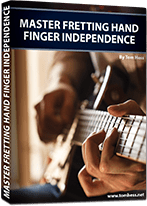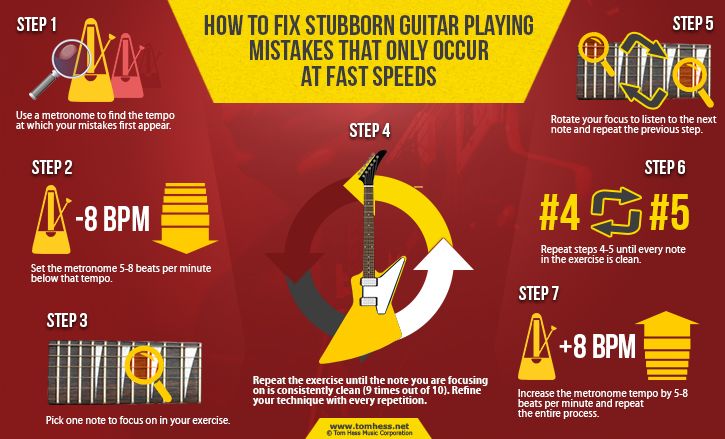The #1 Secret To Developing Advanced Guitar Technique
by Tom Hess
Feel Incredibly Easy

EMAIL TO GET ACCESS
By submitting your info, you agree to send it to Tom Hess Music Corporation who will process and use it according to their privacy policy.
… this article may be the single greatest guitar technique lesson you’ll ever see.
Here is why:
I'm going to show you how to answer almost every guitar technique question you’ll ever have when you practice guitar…
...the very same way advanced guitar players do.
And when you have this skill…
It becomes easy to know what to do when you face a guitar technique problem.
(Or when you have bad habits in your guitar technique.)
The result?
This guitar technique skill makes it almost impossible NOT to become an advanced guitar player.
Ok, enough teasing.
Watch this guitar technique video to see what I'm talking about:
Now that you know how to think about your guitar technique the way advanced guitar players do…
Want to know even more advanced guitar playing principles few guitar players know?
No problem.
Here are some of the secrets I teach my guitar students to help them become advanced guitar players quickly:
Feel Incredibly Easy

EMAIL TO GET ACCESS
By submitting your info, you agree to send it to Tom Hess Music Corporation who will process and use it according to their privacy policy.
Advanced Guitar Playing Secret #1: Set Goals For Each Guitar Practice Session
Everybody knows it’s important to set goals when you practice guitar.
But most guitar players who aspire to reach advanced guitar playing levels set goals all wrong.
(This is true not only in guitar technique, but in all areas of guitar playing.)
How?
They set goals way too far out into the future. (For example: “I want to master my guitar technique or become an advanced guitar player in 3 years.”)
This makes it impossible to know if your guitar playing goals are realistic or not when you practice guitar.
Enter: the #1 goal setting strategy for anyone who wants to become an advanced guitar player:
Set individual goals for each time you practice guitar.
For example: “Repeat this guitar lick 500 times, while focusing on a specific element of guitar technique.” Or: increase my speed with a certain guitar technique (e.g. sweep picking) by 2 bpm in 20 minutes.
These tiny goals are like steps that guide you to the advanced guitar playing levels you want to reach.
You should set these tiny guitar playing goals for all areas of your guitar playing (not only guitar technique.)
And these guitar playing goals make it easy to tell if you improved your guitar technique (or other skills) by the time you finished practicing guitar.
That means: you know what to change next time you sit down to improve your guitar technique (or other areas of your guitar playing).
And that’s how you stay on track towards your ultimate guitar playing goals.
Guitar Practice Expert Mike Philippov calls these tiny guitar playing goals “micro goals”.
Watch this video where he goes into detail about how to set these goals for your guitar technique (and other areas of your guitar playing):
Advanced Guitar Playing Secret #2: Use Focus Rotation When You Practice Guitar Technique
Focus rotation is an awesome way to quickly take your guitar technique to advanced levels.
Here is how to use focus rotation when you practice guitar:
You break your guitar technique down into guitar technique elements that make advanced guitar playing possible.
Some of these guitar technique elements may include:
Picking hand efficiency, fretting hand efficiency, picking had articulation, fretting hand finger independence, 2-hand synchronization, excess tension control, unwanted string noise control and timing.
Next, (after you list these advanced guitar technique elements), start practicing any guitar technique exercise, while focusing on the first of these elements for about 1 minute.
Then, rotate your focus and practice guitar while paying attention to the next element of your guitar playing.
After a minute, rotate your focus again to focus on the 3rd element of your guitar technique as you continue to practice guitar.
Continue your guitar practice this way, until you rotated through all the guitar technique elements on your guitar playing focus rotation list.
This approach lets you improve many elements of your guitar playing with only one exercise.
Follow this process during your guitar practice and you almost can’t fail to reach an advanced level of guitar playing quickly.
Here are 2 bonus ways to use focus rotation to develop advanced guitar technique in your guitar playing:
You can use it to fix guitar playing (and guitar technique) mistakes that only happen at high speeds.
Here is how:
Select any repeating exercise (a scale sequence, an arpeggio or a short lick) to practice.
Follow these guitar practice steps to fix your guitar playing mistakes fast:
Step 1: Find the exact metronome tempo at which your guitar technique mistakes first appear. Write down this tempo and keep track of it as you practice guitar. As your guitar playing (and guitar technique) improve, this metronome speed will get higher and higher.
Step 2: Set the metronome 5-8 beats per minute below that tempo.
Step 3: Pick one note to focus on in your exercise, as shown in this guitar speed video. Let the other notes go by on autopilot. Do not worry if the other notes cause guitar playing mistakes! Stay focused only on the one note you should listen for (more on this below).

Step 4: Repeat the exercise over and over until the note you are focusing on is consistently clean (9 times out of 10). Fix your guitar playing mistakes with every repetition as you practice guitar.
Step 5: Rotate your focus to listen to the next note and repeat the previous step. At this point, you let the previous note you focused on go on autopilot. Focus only on the new note you should be listening for. Analyze your technique & make it perfect.
Step 6: Repeat steps 4-5 until every note in the exercise is clean.
Step 7: Increase the metronome tempo by 5-8 beats per minute and repeat the entire guitar practice process.
You can also use focus rotation to focus on one finger at a time.
Why do this?
Focusing on one finger at a time helps you get clear on guitar technique mistakes you’d normally have a very hard time fixing.
Simply choose a finger to pay attention to and focus on all the notes you play with that finger as you practice guitar.
After a bit of time, shift your focus to listen to the notes you play with another finger. Keep rotating between fingers until you clean up all mistakes in your guitar playing.
This style of guitar practice makes it easy to clean up guitar playing mistakes that only happen past a certain speed threshold (while focusing only on one element of guitar technique at a time).
Advanced Guitar Playing Secret #3: Use Directional Picking When You Practice Guitar Technique
Directional picking is a great way to make your guitar technique more efficient, build more speed faster and reach an advanced level of guitar playing in less time.
But what *is* directional picking?
It’s a way to play guitar fast while using the shortest, most direct path to play the notes you want to play on guitar.
It works like this:
When you pick on a single string – you use strict alternate picking.
But when you change strings – you pick in the direction of the string change.
Meaning:
When you ascend in pitch, you pick the first note on the next higher string with a downstroke all the time. (NO matter what pick stroke you used on a note before).
And when you descend in pitch, you pick the first note on the next lower string with an upstroke all the time. (NO matter what pick stroke you used on a note before).
This means:
You’ll sometimes use sweep picking to change strings in a more efficient way than you could with alternate picking. This is especially common on 3-note-per-string scales.
Want to see the best way to practice directional picking for maximum guitar technique gains?
Watch this video:
Question: “Tom Hess, does directional picking only work for 3-note-per-string scales? What if I want to play pentatonic scales or other scales that don’t have 3 notes on every string?”
Answer: Directional picking works for everything you play. The principle of directional picking is to use the shortest possible path to the next note you need to play. Sometimes the shortest path to your next note is to use alternate picking. Other times, the shortest path is to use sweep picking to change strings and NOT use alternate picking. Integrating both mechanics achieves maximum guitar speed & efficiency with the least amount of effort.
The principle of strict alternate picking is to alternate your pick strokes no matter what…even if doing so forces your hand to make larger and inefficient motions. This forces you to work much harder (and practice a lot longer) to achieve the same amount of guitar speed.
Question: “Tom Hess, isn’t directional picking the same thing as the guitar technique known as “economy picking”?”
Answer: No. With economy picking, you need to preplan your guitar licks to make every string change happen with a sweep pick. This isn’t what happens when you directional pick. With directional picking, you use sweep picking to change strings when you can.
But when you can’t – you don’t. And then you simply follow the principle of the shortest and most direct path to the next note.
Question: “Tom Hess, why do so many great guitar players use strict alternate picking over directional picking?”
Answer: Directional picking is a relatively new guitar picking technique. Alternate picking has been around a lot longer. Most guitar players from the 1980s, 1990s and 2000’s did not have anyone to teach them directional picking when they were beginners. They developed their guitar speed in spite of the inefficiencies of strict alternate picking… not because it is a superior guitar picking technique. They had to work much harder (and longer) to reach their goals.
Advanced Guitar Playing Secret #4: Use The Geometric ApproachTM To Learn Guitar Technique (And Other Areas of Your Guitar Playing) – Not A Linear Approach.
Here is a simple way to explain the geometric approach:
Imagine you are cooking spaghetti for dinner.
Only instead of putting all the pieces of spaghetti into the pot to cook together, you cook one piece of spaghetti at a time.
When your 1 piece of spaghetti is done, you put it on a plate, take the second spaghetti strand and cook it from start to finish.
You repeat the process, one spaghetti piece at a time.
Finally, about 4 hours later, you sit down to eat...
…a cold mess of sticky, unappetizing slop!
Sounds stupid, right?
But for some reason, this is exactly how most people try to learn and practice guitar.
They want to work on one skill and master it from A to Z. Then they move on to another skill, rinse & repeat.
And they are afraid to move on to something else before the first thing is fully mastered.
Just like when cooking spaghetti - this way of learning and practicing guitar makes no sense at all.
Here is why:
You don’t feel full from eating one piece of spaghetti.
And you don’t call yourself a guitar player with only 1 skill (no matter how well you can do it).
To play music, you need many skills. Skills that develop together – just like your spaghetti pieces all cook together. Skills you can make music with long before you master each one.
Yes, it means it’ll be a long time before all of them are mastered. But guess what: it also means, you get to feel (and sound like) a guitar player every step of the way as you work towards mastery.
Plus, imagine there are 100 skills to learn as a guitar player.
If you wait to fully master each skill before starting all over again from scratch...
... you'd literally be starting to play guitar all over again as a beginner 100 times!
I don't know about you - but this doesn't sound very smart to me.
And this is where my Geometric ApproachTM comes in.
When I create a guitar lesson strategy for a new guitar student, I think of ALL the skills (beyond guitar technique) they need to play guitar the way they want.
Then I help my students work on all (or at least: "several" ) of those guitar playing skills at any given time.
This way, as one guitar playing skill improves, your other skills improve alongside it.
This way, you don't develop glaring weaknesses in your playing. (And you gradually fix any weaknesses you do have).
You become the guitar player you want to be a lot faster and get to feel like a true musician, LONG before your skills reach the advanced level.
Now that you know how to quickly take your guitar technique and guitar playing to an advanced level, what’s next?
The next step is to take ALL of your other musical skills to an advanced level and turn your guitar playing into something you can feel immensely proud of.
I can help you with this in my personalized Breakthrough Guitar Lessons. Unlike some other guitar lessons, you don’t get generic, cookie-cutter lessons from me.
You get guitar lessons personalized to your specific guitar playing challenges, musical skill level, musical interests, and of course: your unique musical goals. Hundreds of my guitar students are experiencing nearly lifechanging breakthroughs in their playing as we speak.
To become one of them, click the green “Start Now” button on the banner below to learn more.
 About Tom Hess: Tom Hess is a guitar teacher, music career mentor and guitar teacher trainer. He teaches rock guitar lessons online to students from all over the world and conducts instructional live guitar training events attended by musicians from over 50 countries.
About Tom Hess: Tom Hess is a guitar teacher, music career mentor and guitar teacher trainer. He teaches rock guitar lessons online to students from all over the world and conducts instructional live guitar training events attended by musicians from over 50 countries.
 | Forward this article to your friends |

